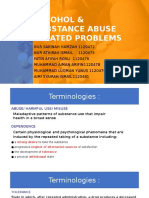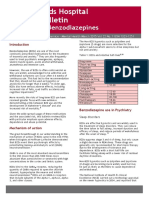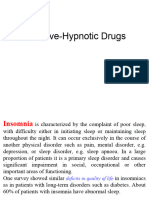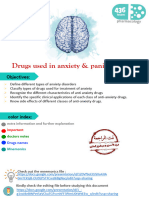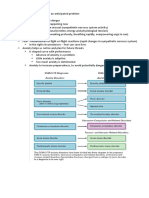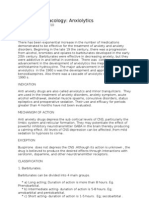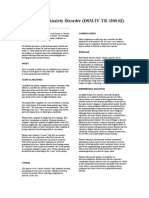0 ratings0% found this document useful (0 votes)
1 viewsChlordiazepoxide and Diazepam
Chlordiazepoxide and Diazepam
Uploaded by
Bandi Sai Hitesh ReddyCopyright:
© All Rights Reserved
Available Formats
Download as DOCX, PDF, TXT or read online from Scribd
Chlordiazepoxide and Diazepam
Chlordiazepoxide and Diazepam
Uploaded by
Bandi Sai Hitesh Reddy0 ratings0% found this document useful (0 votes)
1 views8 pagesCopyright
© © All Rights Reserved
Available Formats
DOCX, PDF, TXT or read online from Scribd
Share this document
Did you find this document useful?
Is this content inappropriate?
Copyright:
© All Rights Reserved
Available Formats
Download as DOCX, PDF, TXT or read online from Scribd
Download as docx, pdf, or txt
0 ratings0% found this document useful (0 votes)
1 views8 pagesChlordiazepoxide and Diazepam
Chlordiazepoxide and Diazepam
Uploaded by
Bandi Sai Hitesh ReddyCopyright:
© All Rights Reserved
Available Formats
Download as DOCX, PDF, TXT or read online from Scribd
Download as docx, pdf, or txt
You are on page 1of 8
Chlordiazepoxide and diazepam were introduced
around 1960 as antianxiety drugs. Since then this
class has proliferated and has replaced barbiturates as hypnotic
and sedative as well, because—
1. BZDs produce a lower degree of neuronal
depression than barbiturates. They have a high
therapeutic index. Ingestion of even 20 hypnotic
doses does not usually endanger life—there is
no loss of consciousness (though amnesia
occurs) and patient can be aroused; respiration
is mostly not so depressed as to need assistance.
2. Hypnotic doses do not affect respiration or
cardiovascular functions. Higher doses produce
mild respiratory depression and hypotension
which is problematic only in patients with
respiratory insufficiency or cardiac/haemodynamic abnormality.
3. BZDs have practically no action on other
body systems. Only on i.v. injection the BP falls
(may be marked in an occasional patient) and
cardiac contractility decreases. Fall in BP in
case of diazepam and lorazepam is due to
reduction in cardiac output while that due to
midazolam is due to decrease in peripheral
resistance. The coronary arteries dilate on i.v.
injection of diazepam.
4. BZDs cause less distortion of sleep architecture; rebound
phenomena on discontinuation of
regular use are less marked.
5. BZDs do not alter disposition of other drugs
by microsomal enzyme induction.
6. They have lower abuse liability: tolerance is
mild, psychological and physical dependence,
drug seeking and withdrawal syndrome are less
marked.
7. A specific BZD antagonist flumazenil is available which can be
used in case of poisoning
CNS actions The overall action of all BZDs
is qualitatively similar, but there are prominent
differences in selectivity for different facets of
action, and in their time-course of action.
Different members are used for different
purposes. In contrast to barbiturates, they are
not general depressants, but exert relatively
selective anxiolytic, hypnotic, muscle relaxant
and anticonvulsant effects in different measures.
Even when apparently anaesthetic dose of
diazepam is administered i.v., some degree of
awareness is maintained, though because of
anterograde amnesia (interference with establishment of memory
trace) the patient does not
clearly recollect the events on recovery.
Antianxiety: Some BZDs exert relatively
selective antianxiety action (see Ch. 33) which
is probably not dependent on their sedative
property. With chronic administration relief of
anxiety is maintained, but drowsiness wanes off
due to development of tolerance.
Sleep: While there are significant differences
among different BZDs, in general, they hasten
onset of sleep, reduce intermittent awakening
and increase total sleep time (specially in those
who have a short sleep span). Time spent in stage
2 is increased while that in stage 3 and 4 is
decreased. They tend to shorten REM phase, but
more REM cycles may occur, so that effect on
total REM sleep is less marked than with barbiturates. Nitrazepam
has been shown to actually
increase REM sleep. Night terrors and body
movements during sleep are reduced and stage
shifts to stage 1 and 0 are lessened. Most
subjects wake up with a feeling of refreshing
sleep. Some degree of tolerance develops to the
sleep promoting action of BZDs after repeated
nightly use.
Muscle relaxant: BZDs produce centrally
mediated skeletal muscle relaxation without
impairing voluntary activity (see Ch. 25).
Clonazepam and diazepam have more marked
muscle relaxant property. Very high doses
depress neuromuscular transmission.
Anticonvulsant: Clonazepam, diazepam, nitrazepam, lorazepam
and flurazepam have more
prominent anticonvulsant activity than other
BZDs. Diazepan and lorazepam are highly
effective for short-term use in status-epilepticus,
but their utility in long-term treatment of
epilepsy is limited by development of tolerance
to the anticonvulsant action.
Given i.v., diazepam (but not others) causes
analgesia. In contrast to barbiturates, BZDs do
not produce hyperalgesia.
Other actions Diazepam decreases nocturnal
gastric secretion and prevents stress ulcers.
BZDs do not significantly affect bowel
movement.
Short-lasting coronary dilatation is produced
by i.v. diazepam.
Site and mechanism of action
Benzodiazepines act preferentially on midbrain
ascending reticular formation (which maintains
wakefulness) and on limbic system (thought and
mental functions). Muscle relaxation is produced
by a primary medullary site of action and ataxia
is due to action on cerebellum.
BZDs act by enhancing presynaptic/postsynaptic inhibition
through a specific BZD
receptor which is an integral part of the GABAA
receptor–Cl¯
channel complex. The subunits of
this complex form a pentameric transmembrane
anion channel (Fig. 29.3) gated by the primary
ligand (GABA), and modulated by secondary
ligands which include BZDs. Only the α and β
subunits are required for GABA action, and most
likely the binding site for GABA is located on
the β subunit, while the α/γ subunit interface
carrys the BZD binding site. The modulatory
BZD receptor increases the frequency of Cl¯
channel opening induced by submaximal
concentrations of GABA. The BZDs also
enhance GABA binding to GABAA receptor.
The GABAA antagonist bicuculline antagonizes
BZD action in a noncompetitive manner. It is
noteworthy that the BZDs do not themselves
increase Cl¯
conductance; have only GABA
facilitatory but no GABA mimetic action. This
probably explains the lower ceiling CNS depressant effect of
BZDs.
The BZD receptor exhibits a considerable
degree of constitutive activation. As such, it is
capable of fine tuning GABA action in either
direction. While the BZD-agonists enhance
GABA induced hyperpolarization (due to influx
of Cl¯
ions), and decrease firing rate of
neurones, other compounds called BZD-inverse
agonists like dimethoxyethyl-carbomethoxy-β-
carboline (DMCM) inhibit GABA action and are
convulsants. The competitive BZD-antagonist
flumazenil blocks the sedative action of BZDs
as well as the convulsant action of DMCM.
The GABAA-BZD receptor-Cl–
channel complex is composed
of five α, β, γ, and in some cases δ, ε, θ or π subunits as
well. Several isoforms of α, β and γ subunits have been cloned.
The subunit composition of the complex differs at different
sites, i.e. there are multiple subtypes of BZD receptor. The
(α12 β2 2 γ2) pentamer appears to be the most commonly
expressed BZD receptor isoform.
Based on studies conducted in genetically mutated mice,
it has been suggested that BZD receptor isoforms containing
the α1 subunit are involved in mediating sedative, hypnotic,
and amnesic actions of BZDs, while those containing α2
subunits mediate anxiolytic and muscle relaxant actions.
Diazepam has similar affinity for BZD receptor containing
different (α1 or α2, or α3 or α5) subunits, and has broad
spectrum action. Receptor inhomogeneity may provide an
explanation for the pharmacological diversity of other BZDs.
The newer non-BZD hypnotics zaleplon, Zolpidem, etc. have
high affinity for α1 subunit isoform of BZD receptor and exert
selective hypnotic-amnesic effect, but have little antiseizure
or muscle relaxant property.
At high concentrations BZDs also potentiate the depressant action
of adenosine by blocking its uptake. Certain
actions of BZDs are countered by the adenosine antagonist
theophylline. Thus, BZDs could be acting through other
mechanisms as well.
There are marked pharmacokinetic differences
among BZDs because they differ in lipidsolubility by > 50 fold.
These differences are
important factors governing their choice for
different uses. Oral absorption of some is rapid
while that of others is slow. Absorption from
i.m. sites is irregular except for lorazepam.
Plasma protein binding also varies markedly
(flurazepam 10% to diazepam 99%). BZDs are
widely distributed in the body. The more lipid
soluble members enter brain rapidly and have
a two phase plasma concentration decay curve;
first due to distribution to other tissues and later
due to elimination. A relatively short duration
of action is obtained with single dose of a drug
that is rapidly redistributed, even though it may
have a long elimination t½. Using the elimination
t½ alone to predict duration of action may be
misleading. However, elimination t½ determines
duration of action in case of drugs whose
elimination is by far the dominant feature or
when the drug is given repeatedly.
Benzodiazepines are metabolized in liver
mainly by CYP3A4 and CYP2C19 to dealkylated
and hydroxylated metabolites, some of which
may be active. The biological effect half-life of
these drugs may be much longer than the plasma
t½ of the administered compound. The phase I
metabolites and certain BZDs themselves are
conjugated with glucuronic acid. Some BZDs
(e.g. diazepam) undergo enterohepatic circulation. BZDs and their
phase I metabolites are
excreted in urine as glucuronide conjugates.
BZDs cross placenta and are secreted in milk.
Drugs with a long t½ or those which generate
active metabolites cumulate on nightly use; their
action may then extend into the next day. Some
features of BZDs used as hypnotic are given in
Table 29.1.
BZDs may be categorized according to their
pharmacokinetic profile into:
I. Slow elimination of parent drug or active
metabolite
Flurazepam Produces an active metabolite
which has a long t½. Residual effects are likely
next morning; cumulation occurs on daily
ingestion peaking after 3–5 days. It is suitable
for patients who have frequent nocturnal awakenings and in
whom some day time sedation is
acceptable.
NINDRAL, FLURAZ 15 mg cap.
II. Relatively slow elimination but marked
redistribution
Diazepam It is the oldest and all purpose
BZD, used as anxiolytic, hypnotic, muscle
relaxant, premedicant, anaesthetic and for
emergency control of seizures due to its broad
spectrum activity. It generates active metabolites
(desmethyl-diazepam, oxazepam). On occasional
use it is free of residual effects. With regular
use accumulation occurs and prolonged anxiolytic effect may be
obtained. It is less likely
to cause rebound insomnia on discontinuation
of chronic use. Withdrawal phenomena are mild.
VALIUM 2, 5, 10 mg tab., 10 mg/2 ml inj., CALMPOSE 2.5, 5, 10
mg tab, 2 mg/5 ml syr, 10 mg/2 ml inj, PLACIDOX 2, 5, 10 mg tab,
10 mg/2 ml inj.
Nitrazepam Dose to dose equipotent as
diazepam. Accumulation and residual effects can
be avoided only if ingestion is occasional. Good
for patients with frequent nocturnal awakenings,
when some day time sedation is acceptable.
SEDAMON, HYPNOTEX, NITRAVET 5 mg tab., 5, 10 mg cap.
III. Relatively rapid elimination and
marked redistribution
Alprazolam The primary indication of this
potent and intermediate acting BZD is anxiety
disorder (see Ch. 33), but it is also being
employed as night-time hypnotic with few
residual effects the next day. Discontinuation
after regular use has produced relatively marked
withdrawal phenomena.
Temazepam It is an intermediate acting BZD. Absorption
is slow in case of tablet but fast when used in soft gelatin
capsule. Good for sleep onset difficulty, free of residual effects.
Accumulation can occur on daily ingestion. Does not produce
active metabolites.
IV. Ultrarapid elimination
Triazolam Very potent, peak effect occurs in < 1 hour;
good for sleep induction but poor for maintaining it. Patient
may wake up early in the morning and feel anxious. This may
be a withdrawal phenomenon. Rebound insomnia may occur
when it is discontinued after a few nights of use. It does
not accumulate on repeated nightly use and no residual effects
are noted in the morning. However, higher doses can alter
sleep architecture, produce anterograde amnesia and anxiety
the following day. Some cases of paranoia and other
psychiatric disturbances have been noted. For this reason,
it has been withdrawn from U.K., but is employed in other
countries for elderly patients, shift workers, travellers, etc.
Midazolam Extremely rapid absorption—peak in 20 min.
It can cause problems in the elderly (ataxia, blackouts); more
liable for abuse. Therefore, it is not available now for oral
use as a hypnotic. It is mainly used as an i.m. premedicant
or an i.v. anaesthetic (see p. 383).
ADVERSE EFFECTS
Benzodiazepines are relatively safe drugs. Side
effects of hypnotic doses are dizziness, vertigo,
ataxia, disorientation, amnesia, prolongation of
reaction time—impairment of psychomotor
skills (should not drive). Hangover is less
common, but may be noted if larger doses are
used, especially of longer acting drugs.
Weakness, blurring of vision, dry mouth and
urinary incontinence are sometimes complained.
Older individuals are more susceptible to
You might also like
- Sedative - HypnoticsDocument60 pagesSedative - HypnoticsNurul AinNo ratings yet
- Ethanol ToxicityDocument11 pagesEthanol Toxicitymanueljose8No ratings yet
- Seminar Substance AbuseDocument78 pagesSeminar Substance AbuseAiman ArifinNo ratings yet
- Treatment WorkbookDocument112 pagesTreatment Workbookkmurphy100% (15)
- Hypnotics and Sedatives PDFDocument35 pagesHypnotics and Sedatives PDFSayan Nag100% (1)
- Anxiolytic DrugsDocument44 pagesAnxiolytic DrugschkiershadiNo ratings yet
- Sedative 2024Document38 pagesSedative 2024mohammaddammagNo ratings yet
- Anxiolytic & Hypnotics Part 1Document28 pagesAnxiolytic & Hypnotics Part 1Sarah ArkanNo ratings yet
- 911 Sedative-Hypnotics PDFDocument17 pages911 Sedative-Hypnotics PDFIkram HamacheNo ratings yet
- Sedative HypnoticsDocument39 pagesSedative HypnoticsFatima ShaukatNo ratings yet
- Dr. Rahul Trivedi B.R.Nahata College of Pharmacy, Department of Pharmacy, Mandsaur UniversityDocument16 pagesDr. Rahul Trivedi B.R.Nahata College of Pharmacy, Department of Pharmacy, Mandsaur UniversityVampire Vampire100% (1)
- Hypnotics and SedativesDocument15 pagesHypnotics and SedativescchatrumaNo ratings yet
- Sedative - HypnoticsDocument62 pagesSedative - HypnoticsvijayNo ratings yet
- 02 Intoxicacion Benzodiacepinas PDFDocument11 pages02 Intoxicacion Benzodiacepinas PDFDilia Dourdane AvilaNo ratings yet
- SedativeDocument15 pagesSedativeManul ShobujNo ratings yet
- Pharm 2 TESTDocument26 pagesPharm 2 TESTRachel MackeyNo ratings yet
- Sedative & Hypnotics: Prof. Hanan Hagar Pharmacology Department Medical College King Saud UniversityDocument51 pagesSedative & Hypnotics: Prof. Hanan Hagar Pharmacology Department Medical College King Saud UniversityRose Ann Raquiza-PeranteNo ratings yet
- Graylands Hospital Drug Bulletin: Focus On BenzodiazepinesDocument4 pagesGraylands Hospital Drug Bulletin: Focus On BenzodiazepinesStacia Carla CarolineNo ratings yet
- Central Nervous System Agents: ObjectivesDocument47 pagesCentral Nervous System Agents: ObjectivesKeith OmwoyoNo ratings yet
- Benzodiazepines ToxicityDocument19 pagesBenzodiazepines ToxicityNagendra NayakNo ratings yet
- Benzodiazepine Poisoning PDFDocument18 pagesBenzodiazepine Poisoning PDFNeicu Marius-RăzvanNo ratings yet
- Flumazenil Reverses The CNS Effects of BZDDocument3 pagesFlumazenil Reverses The CNS Effects of BZDLouradel AlfonsoNo ratings yet
- 2012 Sedative Hypnotic DrugsDocument38 pages2012 Sedative Hypnotic DrugsHiwa Khidhir saaedNo ratings yet
- Pharmacology of Sedative-Hypnotics: DR - Datten Bangun, MSC, SPFK Dept - Farmakologi & Terapetik Fak - Kedokteran Uhn MedanDocument49 pagesPharmacology of Sedative-Hypnotics: DR - Datten Bangun, MSC, SPFK Dept - Farmakologi & Terapetik Fak - Kedokteran Uhn MedanGeorge AbrahamNo ratings yet
- Drugs Acting On The CNS - 2Document41 pagesDrugs Acting On The CNS - 2Daniel OkakaNo ratings yet
- Barbiturates and Non Barbiturates Sedative HypnoticsDocument10 pagesBarbiturates and Non Barbiturates Sedative Hypnoticsrossfancy736No ratings yet
- Benzodiazepines and Hypnotics: Key PointsDocument4 pagesBenzodiazepines and Hypnotics: Key Pointssaman mousaviNo ratings yet
- BSCN SEDATIVE &HYPNOTICSDocument20 pagesBSCN SEDATIVE &HYPNOTICStmesam9No ratings yet
- Pharm 7 Sedative Hypnotics & General Anesthesia 2022 (Student)Document66 pagesPharm 7 Sedative Hypnotics & General Anesthesia 2022 (Student)aaronkinnear713No ratings yet
- Drugs Affecting CNS & PNSDocument131 pagesDrugs Affecting CNS & PNSMj Briones100% (1)
- SEDATIVE and HYPNOTIC DRUGSDocument5 pagesSEDATIVE and HYPNOTIC DRUGSVaishali Prashar100% (1)
- Anti Anxiety DrugsDocument13 pagesAnti Anxiety DrugsVamsi Krishna100% (1)
- Anxiolytics, Sedative & Hypnotic DrugsDocument22 pagesAnxiolytics, Sedative & Hypnotic DrugsPh Hany MohamedNo ratings yet
- Restoration of GABAA Receptor Function After Benzodiazepine Use - A Meta-AnalysisDocument19 pagesRestoration of GABAA Receptor Function After Benzodiazepine Use - A Meta-AnalysisLucasNo ratings yet
- AnxiolyticsDocument56 pagesAnxiolyticsjabari.baraNo ratings yet
- Sedatives and HypnoticsDocument4 pagesSedatives and HypnoticsogbeopeNo ratings yet
- Sedative Hypnotics PCI PatternDocument67 pagesSedative Hypnotics PCI PatternI DNo ratings yet
- Anxiolytic DrugsDocument60 pagesAnxiolytic Drugsneleh grayNo ratings yet
- Sedative & HypnoticsDocument32 pagesSedative & HypnoticsSaniya00No ratings yet
- Mohammad Ryad Goulvaden 5 Year, Faculty of PharmacyDocument40 pagesMohammad Ryad Goulvaden 5 Year, Faculty of PharmacypharmryadNo ratings yet
- Sedative Hypnotic Drugs - ArfDocument69 pagesSedative Hypnotic Drugs - Arfaditia1984No ratings yet
- IV Anesthesia - Benzodiazepines: Historical PointsDocument3 pagesIV Anesthesia - Benzodiazepines: Historical PointsAstrid Ghea GayatriNo ratings yet
- AnxiolyticsDocument12 pagesAnxiolyticsIbraheem JabbarNo ratings yet
- Sedative-Hypnotics (SeH) and AnxiolyticsDocument101 pagesSedative-Hypnotics (SeH) and Anxiolyticsmatchees-gone rogueNo ratings yet
- Toxicología Clínica Goldfrank Capítulo Intoxicación SedantesDocument7 pagesToxicología Clínica Goldfrank Capítulo Intoxicación SedantesDavid Andrés BravoNo ratings yet
- Hypnotic and SedativeDocument16 pagesHypnotic and SedativeAnim 2499No ratings yet
- Sedative and HypnoticsDocument26 pagesSedative and HypnoticsZarish IftikharNo ratings yet
- Pharma AnxietyDocument19 pagesPharma AnxietySomaia mohammedNo ratings yet
- Sedative HypnoticsDocument33 pagesSedative HypnoticsIkram HamacheNo ratings yet
- GP Drug & Alcohol Supplement No.9: February 1998Document5 pagesGP Drug & Alcohol Supplement No.9: February 1998NiteshNo ratings yet
- Text Book Section 3 Drugs That Act On The Central NervousDocument35 pagesText Book Section 3 Drugs That Act On The Central NervousAngelita RuntukNo ratings yet
- Anestheticagents Commonlyusedbyoral AndmaxillofacialsurgeonsDocument10 pagesAnestheticagents Commonlyusedbyoral Andmaxillofacialsurgeonscarlos gilbertoNo ratings yet
- SedativeDocument35 pagesSedativeking_goldNo ratings yet
- 5 Sedative-Hypnotic DrugsDocument26 pages5 Sedative-Hypnotic DrugsDylan Panashe KwendaNo ratings yet
- Anxiolytic & Hypnotics Part 2Document24 pagesAnxiolytic & Hypnotics Part 2Sarah ArkanNo ratings yet
- Medicam PT InsomnDocument13 pagesMedicam PT InsomnDoina DoniciNo ratings yet
- PM3102 Q2Document3 pagesPM3102 Q2rexlloydNo ratings yet
- DiazepamDocument6 pagesDiazepamF - TOMELDAN, CERESNo ratings yet
- Drugs Acting On CNSDocument19 pagesDrugs Acting On CNSAditya sagarNo ratings yet
- Short Notes On Sedatives and HypnoticsDocument15 pagesShort Notes On Sedatives and HypnoticsPratham KhairnarNo ratings yet
- Sedative and Hypnotic-Induced Mental Health Disorders: Understanding Behavioral ImpactsFrom EverandSedative and Hypnotic-Induced Mental Health Disorders: Understanding Behavioral ImpactsNo ratings yet
- Critical Care Medications: Vasopressors, Inotropes and Anti-Hypertensives Study Guide: Critical Care EssentialsFrom EverandCritical Care Medications: Vasopressors, Inotropes and Anti-Hypertensives Study Guide: Critical Care EssentialsNo ratings yet
- 8-Drugs Used in Anxiety and Panic Disprder (Edited)Document8 pages8-Drugs Used in Anxiety and Panic Disprder (Edited)himanshukumar839496No ratings yet
- Lectopam: Product MonographDocument19 pagesLectopam: Product MonographMohammed Shamiul ShahidNo ratings yet
- Chalcone Derivative Synthesis 1Document35 pagesChalcone Derivative Synthesis 1Ankit Kumar SinghNo ratings yet
- Mcqs PsychiatryDocument27 pagesMcqs Psychiatrypriya009100% (6)
- Kring Abnormal Psychology Chapter 6 Anxiety NotesDocument16 pagesKring Abnormal Psychology Chapter 6 Anxiety NotesAnn Ross Fernandez50% (2)
- Local AnesthesiaDocument40 pagesLocal AnesthesiaKY HoNo ratings yet
- Psychiatry Passmedicine & Onexamination Notes 2016 PDFDocument34 pagesPsychiatry Passmedicine & Onexamination Notes 2016 PDFJyothi ReddyNo ratings yet
- XENOKRATEZ'17 - 2nd Year Question BankDocument210 pagesXENOKRATEZ'17 - 2nd Year Question BankJohithNo ratings yet
- Pharmacology CNS DrugsDocument7 pagesPharmacology CNS DrugsDavid Hosam100% (1)
- Drug Class Review On BenzosDocument48 pagesDrug Class Review On BenzosRico RodriguezNo ratings yet
- AnxityDocument16 pagesAnxitya7med7212No ratings yet
- 2017 Syllabus - MVH Modular Sedation SeriesDocument11 pages2017 Syllabus - MVH Modular Sedation SeriesyalahopaNo ratings yet
- AnxiolyticsDocument10 pagesAnxiolyticsSharon PanaderoNo ratings yet
- Psychiatric NursingDocument5 pagesPsychiatric NursingiyeelovenajeeNo ratings yet
- Drug InteracttionDocument8 pagesDrug InteracttionMuh. AnugrawanNo ratings yet
- Community Stress Prevention Volume 5 PDFDocument149 pagesCommunity Stress Prevention Volume 5 PDFEmina KapetanovicNo ratings yet
- The Asam Clinical Practice Guideline On Alcohol-1Document74 pagesThe Asam Clinical Practice Guideline On Alcohol-1adrian prasetio100% (1)
- Local Anesthetics, IV Sedation and Pain ManagementDocument70 pagesLocal Anesthetics, IV Sedation and Pain ManagementHosam GomaaNo ratings yet
- Oral and Maxillofacial Surgery Clinics of North America Office Based Anesthesia 45 57Document13 pagesOral and Maxillofacial Surgery Clinics of North America Office Based Anesthesia 45 57Max FaxNo ratings yet
- 2.20140209 Question PaperDocument16 pages2.20140209 Question PaperdrpnnreddyNo ratings yet
- Top 5 Emergencies Requiring AnesthesiaDocument4 pagesTop 5 Emergencies Requiring AnesthesiaLuciaNo ratings yet
- Baby Katzung - Second Shifting ReviewerDocument13 pagesBaby Katzung - Second Shifting ReviewerEunikaificationNo ratings yet
- EtizolamDocument22 pagesEtizolamvinodksahuNo ratings yet
- Generalized Anxiety Disorder (DSM-IV-TR #300.02) : ComplicationsDocument3 pagesGeneralized Anxiety Disorder (DSM-IV-TR #300.02) : Complicationsfegx_17No ratings yet
- Quiz Neuroscience Part 4 of 4Document59 pagesQuiz Neuroscience Part 4 of 4MedShare100% (3)
- 2022 Anesth s1t8 Intravenous Anesthesia and OpioidsDocument10 pages2022 Anesth s1t8 Intravenous Anesthesia and OpioidsmedicoNo ratings yet
- Type of DepressantsDocument36 pagesType of Depressantsadrian YriganNo ratings yet


